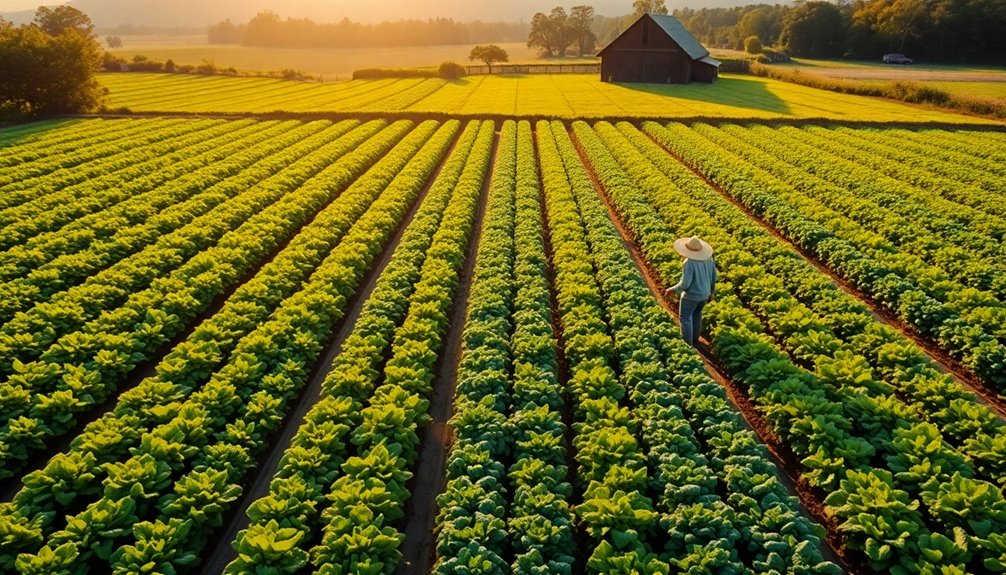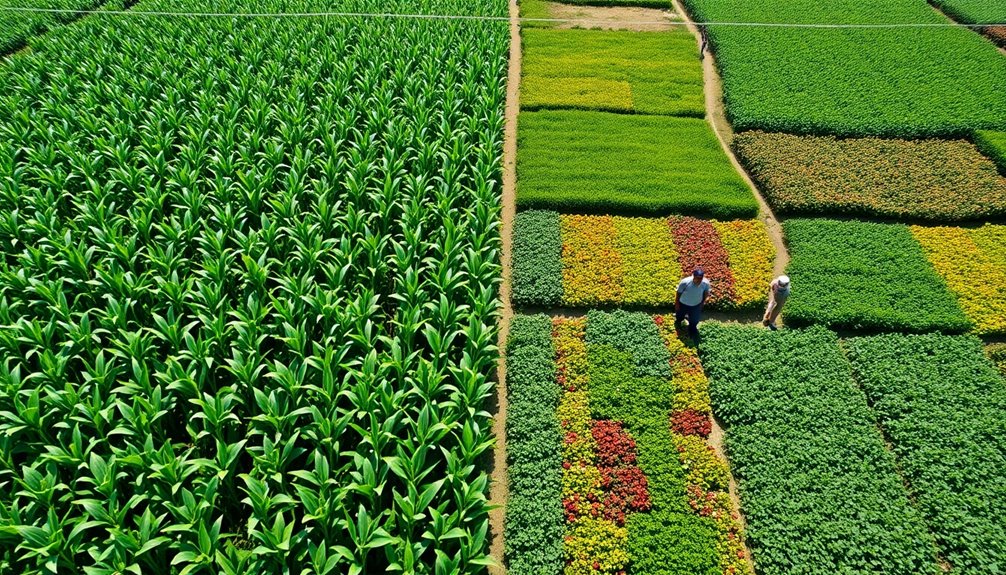To succeed at farmers markets, focus on competitive yet fair pricing and clear signage to attract customers. Use eye-catching packaging that reflects the quality of your produce, like rustic wraps or branded labels. Keep your displays clean and colorful, and consider offering samples or bulk discounts to encourage sales. Don’t forget to experiment with pricing and presentation based on feedback. With these tips, you’ll build trust and boost your stall’s reputation—more strategies await your attention.
Key Takeaways
- Price competitively by researching market rates and offering discounts for bulk purchases.
- Use attractive, branded packaging and clear signage to enhance visual appeal.
- Present produce in neat, sturdy containers with eco-friendly wraps for delicate items.
- Incorporate rustic decor and vintage signage to strengthen branding and attract customers.
- Gather customer feedback, adjust pricing and packaging strategies, and focus on fair pricing to build trust.

Selling produce at farmers markets can be a rewarding way to connect with your community and turn your hard work into income. To succeed, you need to pay attention to how you price your items and present them. Effective pricing strategies are essential because they determine how much customers are willing to pay and whether your stall stands out among others. Start by researching what similar vendors are charging for comparable produce. You want your prices to be competitive but also reflect the quality of your goods. Consider offering tiered pricing or discounts for bulk purchases to encourage larger sales and reward loyal customers. Also, be transparent about your prices—clear signage helps customers make quick decisions without feeling confused or unsure.
Packaging techniques play an equally important role in attracting buyers and protecting your produce. Well-thought-out packaging not only keeps your items fresh but also enhances their visual appeal. Use sturdy containers that prevent damage and make it easy for customers to carry their purchases. For delicate items like berries or herbs, consider using eco-friendly wraps or small baskets that showcase the freshness of your produce. Label everything clearly with prices and product information; this adds professionalism and makes checkout smoother. Bright, attractive labels with your farm’s name can help build your brand and encourage repeat customers. When packaging, think about the overall presentation—neat, clean, and appealing displays draw more eyes and can justify higher prices. Incorporating rustic decor elements such as burlap wraps or vintage signage can further enhance the farmhouse charm and attract more customers. Additionally, using sustainable packaging options can appeal to eco-conscious shoppers and set your stall apart in the marketplace.
It’s also wise to think about how your pricing strategies align with your packaging choices. For example, offering small sample-sized portions or mini baskets can entice buyers to try new items and lead to larger purchases. Keep in mind that packaging should complement your pricing; if you’re charging premium prices, your packaging should reflect that quality. A thoughtful approach to packaging can help reinforce the perceived value of your produce and build customer trust. Incorporating professional branding into your packaging can also help establish trust and a memorable impression. For rural or rustic markets, incorporating vintage or farmhouse-inspired packaging elements can enhance the overall appeal and attract more customers. Conversely, if you’re focusing on affordability, simple, functional packaging might be more appropriate.
Ultimately, how you price and package your produce can greatly influence your sales and reputation. Take the time to experiment, gather feedback, and adjust as needed. When your pricing strategies are fair and your packaging is appealing, customers will feel confident buying from you. This combination helps build trust, encourages repeat business, and makes your farmers market experience both profitable and enjoyable.
Frequently Asked Questions
How Do I Set Competitive Prices for My Produce?
To set competitive prices for your produce, start with solid pricing strategies by researching your local market. Look at what nearby vendors charge and consider your costs to guarantee a fair profit. Conduct market research regularly to stay updated on trends and customer preferences. Adjust your prices accordingly, balancing affordability with profitability. Remember, competitive pricing attracts more customers while covering expenses, helping you succeed at farmers markets.
What Permits and Certifications Are Required to Sell at Farmers Markets?
Charting permits and certifications is like steering a course through uncharted waters. You’ll need to check local health regulations and obtain vendor licensing requirements before selling at farmers markets. These steps ensure you’re legally protected and build trust with customers. Contact your local health department or farmers market authority to get clear guidance. Staying compliant isn’t just a chore; it’s the foundation for a successful and sustainable selling experience.
How Can I Attract More Customers to My Stall?
To attract more customers to your stall, focus on eye-catching visual merchandising that highlights your produce’s freshness and quality. Use vibrant displays and clear signage to draw attention. Don’t forget to promote your stall on social media; share photos, updates, and special offers to engage your audience. Combining appealing visual merchandising with active social media promotion helps you stand out, bringing more foot traffic and boosting sales.
What Are the Best Practices for Handling Perishable Produce?
Like a time traveler from the future, you understand that handling perishables requires careful handling storage and temperature control. Keep your produce refrigerated or in cool, shaded areas to prevent spoilage. Use insulated containers for transport, and regularly check temperatures. Handle produce gently to avoid bruising, and display it promptly. These best practices help maintain freshness, reduce waste, and ensure your customers enjoy high-quality, delicious produce every time they visit your stall.
How Do I Manage Inventory and Avoid Waste Effectively?
To manage your inventory and avoid waste, you should implement effective storage techniques to prolong freshness and prevent spoilage. Keep track of your stock regularly, rotating older produce to the front and using first-in, first-out practices. Use proper refrigeration for sensitive items, and consider donation options for excess produce. By staying organized and vigilant, you’ll reduce spoilage and make the most of your harvest, ensuring your customers always get quality goods.
Conclusion
Now that you know the secrets to thriving at farmers markets, remember to stay flexible and genuine, just like the trusty steed of old. Keep your produce fresh, engage with customers warmly, and don’t be afraid to try new ideas. With patience and passion, you’ll turn your humble stall into a bustling hub of local goodness. As the old saying goes, “A rising tide lifts all boats”—so let your dedication be the wind in your sales.










